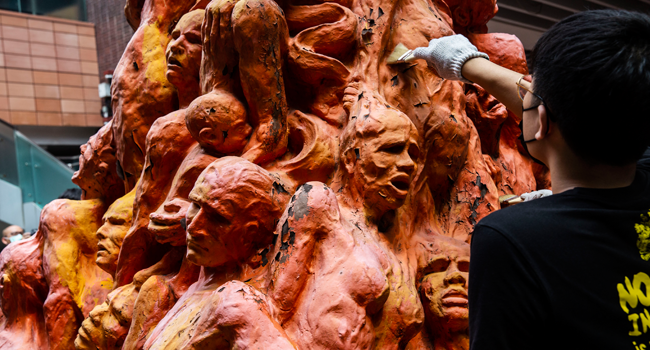Hong Kong’s oldest university has ordered the removal of a statue commemorating protesters killed in China’s 1989 Tiananmen Square crackdown, according to a legal letter released Friday, IgbereTV reports.

The eight-metre (26-foot) high copper statue was the centrepiece of Hong Kong’s candlelit vigil on June 4 to commemorate those killed when Chinese troops backed by tanks opened fire on unarmed pro-democracy campaigners in Beijing.
The statue shows 50 anguished faces and tortured bodies piled on one another, and has been on display at the university campus for more than two decades.
The decision was blasted by the statue’s Danish sculptor Jens Galschiot, who told AFP its removal illustrated the ongoing purge of dissent in the once outspoken and semi-autonomous business hub.
In a legal letter to the now-disbanded Hong Kong Alliance (HKA) — the organiser of the city’s huge annual Tiananmen vigil — the University of Hong Kong (HKU) demanded the group “immediately… make arrangements for the sculpture to be removed from the university’s premises” by 5pm on October 13.
“If you fail to remove the sculpture… it will be deemed abandoned,” the letter said.
It added that the university will deal with the statue in a manner it sees fit without further notice.
Richard Tsoi, former member of HKA’s standing committee, said the university’s request was “unreasonable” and he has sent a request to HKU’s chancellor to keep the statue.
“As a space with free speech and academic freedom, the University of Hong Kong has the social responsibility and mission to preserve the ‘Pillar of Shame’,” Tsoi said in a statement.
In an email reply to AFP on Monday, the statue’s creator Jens Galschiot said he was “shocked if there were plans to desecrate the only memorial to such a consequential and important event in Chinese history”.
“I wish that the Pillar stays in Hong Kong, at the same place as it stands today. That would be historically correct. The pillar is an important artwork that has a historic link to Hong Kong and should stay on Chinese land,” Galschiot said.
The HKU said its request was “based on the latest risk assessment and legal advice”.






